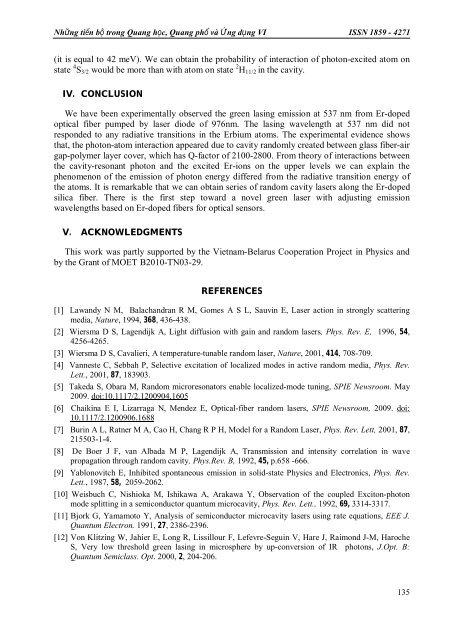Nhng tin b trong Quang hc, Quang ph và ng dng VI ISSN 1859 - 4271
Nhng tin b trong Quang hc, Quang ph và ng dng VI ISSN 1859 - 4271
Nhng tin b trong Quang hc, Quang ph và ng dng VI ISSN 1859 - 4271
Create successful ePaper yourself
Turn your PDF publications into a flip-book with our unique Google optimized e-Paper software.
Nhữ<strong>ng</strong> tiến bộ <stro<strong>ng</strong>>tro<strong>ng</strong></stro<strong>ng</strong>> <stro<strong>ng</strong>>Qua<strong>ng</strong></stro<strong>ng</strong>> học, <stro<strong>ng</strong>>Qua<strong>ng</strong></stro<strong>ng</strong>> <stro<strong>ng</strong>>ph</stro<strong>ng</strong>>ổ và Ứ<strong>ng</strong> dụ<strong>ng</strong> <strong>VI</strong> <strong>ISSN</strong> <strong>1859</strong> - <strong>4271</strong>(it is equal to 42 meV). We can obtain the probability of interaction of <stro<strong>ng</strong>>ph</stro<strong>ng</strong>>oton-excited atom onstate 4 S 3/2 would be more than with atom on state 2 H 11/2 in the cavity.IV. CONCLUSIONWe have been experimentally observed the green lasi<strong>ng</strong> emission at 537 nm from Er-dopedoptical fiber pumped by laser diode of 976nm. The lasi<strong>ng</strong> wavele<strong>ng</strong>th at 537 nm did notresponded to any radiative transitions in the Erbium atoms. The experimental evidence showsthat, the <stro<strong>ng</strong>>ph</stro<strong>ng</strong>>oton-atom interaction appeared due to cavity randomly created between glass fiber-airgap-polymer layer cover, which has Q-factor of 2100-2800. From theory of interactions betweenthe cavity-resonant <stro<strong>ng</strong>>ph</stro<strong>ng</strong>>oton and the excited Er-ions on the upper levels we can explain the<stro<strong>ng</strong>>ph</stro<strong>ng</strong>>enomenon of the emission of <stro<strong>ng</strong>>ph</stro<strong>ng</strong>>oton energy differed from the radiative transition energy ofthe atoms. It is remarkable that we can obtain series of random cavity lasers alo<strong>ng</strong> the Er-dopedsilica fiber. There is the first step toward a novel green laser with adjus<s<stro<strong>ng</strong>>tro<strong>ng</strong></stro<strong>ng</strong>>>tin</s<stro<strong>ng</strong>>tro<strong>ng</strong></stro<strong>ng</strong>>>g emissionwavele<strong>ng</strong>ths based on Er-doped fibers for optical sensors.V. ACKNOWLEDGMENTSThis work was partly supported by the Vietnam-Belarus Cooperation Project in Physics andby the Grant of MOET B2010-TN03-29.REFERENCES[1] Lawandy N M, Balachandran R M, Gomes A S L, Sauvin E, Laser action in s<stro<strong>ng</strong>>tro<strong>ng</strong></stro<strong>ng</strong>>ly scatteri<strong>ng</strong>media, Nature, 1994, 368, 436-438.[2] Wiersma D S, Lagendijk A, Light diffusion with gain and random lasers, Phys. Rev. E, 1996, 54,4256-4265.[3] Wiersma D S, Cavalieri, A temperature-tunable random laser, Nature, 2001, 414, 708-709.[4] Vanneste C, Sebbah P, Selective excitation of localized modes in active random media, Phys. Rev.Lett., 2001, 87, 183903.[5] Takeda S, Obara M, Random microresonators enable localized-mode tuni<strong>ng</strong>, SPIE Newsroom. May2009. doi:10.1117/2.1200904.1605[6] Chaikina E I, Lizarraga N, Mendez E, Optical-fiber random lasers, SPIE Newsroom, 2009. doi:10.1117/2.1200906.1688[7] Burin A L, Ratner M A, Cao H, Cha<strong>ng</strong> R P H, Model for a Random Laser, Phys. Rev. Lett, 2001, 87,215503-1-4.[8] De Boer J F, van Albada M P, Lagendijk A, Transmission and intensity correlation in wavepropagation through random cavity, Phys.Rev. B, 1992, 45, p.658 -666.[9] Yablonovitch E, Inhibited spontaneous emission in solid-state Physics and Electronics, Phys. Rev.Lett., 1987, 58, 2059-2062.[10] Weisbuch C, Nishioka M, Ishikawa A, Arakawa Y, Observation of the coupled Exciton-<stro<strong>ng</strong>>ph</stro<strong>ng</strong>>otonmode split<s<stro<strong>ng</strong>>tro<strong>ng</strong></stro<strong>ng</strong>>>tin</s<stro<strong>ng</strong>>tro<strong>ng</strong></stro<strong>ng</strong>>>g in a semiconductor quantum microcavity, Phys. Rev. Lett., 1992, 69, 3314-3317.[11] Bjork G, Yamamoto Y, Analysis of semiconductor microcavity lasers usi<strong>ng</strong> rate equations, EEE J.Quantum Electron. 1991, 27, 2386-2396.[12] Von Klitzi<strong>ng</strong> W, Jahier E, Lo<strong>ng</strong> R, Lissillour F, Lefevre-Seguin V, Hare J, Raimond J-M, HarocheS, Very low threshold green lasi<strong>ng</strong> in micros<stro<strong>ng</strong>>ph</stro<strong>ng</strong>>ere by up-conversion of IR <stro<strong>ng</strong>>ph</stro<strong>ng</strong>>otons, J.Opt. B:Quantum Semiclass. Opt. 2000, 2, 204-206.135















